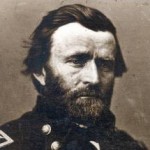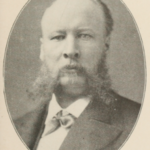General Grant’s Longest Battle
On November 8, 1884, Ulysses S. Grant visited the office of New York City dentist, Dr. Frank Abbott, who extracted Grant’s right maxillary first molar, a procedure Grant said gave him immediate relief from the “neuralgia” he had been suffering. Six days later Grant returned for the extraction of his upper right second and third molars. In addition, Abbott filled several cavities and cleaned Grant’s remaining teeth.
With nearly three decades of experience, during which time he became Dean of the New York University College of Dentistry, wrote numerous articles for professional journals, and developed improved dental instruments, Abbott was one of the city’s most prestigious dentists. The work he did on the former president’s teeth was probably the best dental care Grant had ever received. It was also the last.
The previous month Grant had learned he was suffering from inoperable throat cancer. Despite almost daily treatments by doctors, the Civil War hero and former head of state succumbed to the disease eight months later on July 23, 1885.
*****
Dental care was not a high priority for Americans in the early nineteenth century. Most of it, in fact, consisted of extractions performed by undertrained practitioners without benefit of anesthetic. Such was likely the case in 1837 when Grant’s father, Jesse, was billed fifty cents by a Georgetown, Ohio, dentist for “extracting 1 tooth for Ulisses.” As Grant’s dental history is not well documented, this removal at fifteen years of age may or may not have been Grant’s first extraction, but it was followed by numerous others.
Grant embarked on a military career following his 1843 graduation from West Point, a probable indication of minimal dental care as the United States Army had no dental corps until after 1900. Surgeons were issued instruments to extract teeth but none to repair them. Enlisted men who practiced dentistry as civilians would sometimes treat their fellow soldiers, but typically a soldier either sought treatment off post by a civilian dentist or suffered pain until extraction was his only alternative.
A letter Grant wrote to his wife, Julia, in February 1854 indicates he did both:
I have been suffering for the last few days most terribly. . . . That tooth I had set in Wattertown [six] (you remember how much I suffered at the time) has been giving me the same trouble over again. Last evening I had it drawn and it was much harder to get out than any other tooth would have been. My face is swollen until it is as round as an apple and so tender that I do not feel as if I could shave, so looking at the glass, I think I could pass readily for a person of forty-five. [He was thirty-one.]
Between 1848 and 1852, Grant had been stationed at Sackets Harbor, New York, near Watertown, where he apparently sought out a dentist to treat the tooth that again caused him trouble in 1854 when he was assigned to the remote Pacific Northwest. The painful extraction he described to Julia was probably done by an army surgeon or his assistant. Biographer Jean Edward Smith in Grant writes, “Fort Humboldt post returns list him [Grant] as ‘sick’ for the month of February.”
Much has been written about Grant’s abuse of alchohol during his stint in northern California. Some allege he drank because he was bored or because he missed Julia and his children. Others, less kind, contend he was simply a drunk. Several factors may have been involved, and it is reasonable to assume that drinking to lessen the discomfort of an aching tooth followed by the pain of a brutal extraction was among them.
Grant resigned from the army in August 1854 and spent the next seven years in St. Louis, Missouri, and Galena, Illinois, at a series of unsuccessful jobs. I found no records of dental work during this period of his life, but another letter to Julia, written in February 1863 during the Vicksburg Campaign, suggests he had had significant work done between his resignation in 1864 and his re-entry into the army in 1861:
I met with a great loss this morning. Last night, contrary to my usual habit, I took my teeth out and put them in a wash basin and covered them with water. This morning the servant who attends to my stateroom . . . came in about daylight and finding water in the bason [sic] threw it out into the river teeth and all. I wrote to Dr. Hamline by the same Mail that take[s] this to bring with him if he should come down here material to take an impression and make me a new set.
Dr. Hamline is presumed to be a civilian dentist whom Grant patronized; the General thought he might be in Memphis and asked Julia to send “one of the officers to hunt him up and tell him of my misfortune.” Again, records are unavailable and whether Dr. Hamline or another dentist came to his rescue, Grant was on a soft diet for some time before being outfitted with new dentures. The number of teeth comprising the dentures is unknown, but Dr. Abbott’s extracting three teeth and filling others in 1884 confirms that the artificial teeth tossed into the Mississippi in 1863 were a partial rather than a full set of dentures.
The Civil War ended in 1865, but Grant continued to battle dental issues. In September 1877, six months after the conclusion of his eight years as President, Grant and Julia embarked on a world cruise that took them to Europe, Russia, Egypt, India, and China. Nearly two years later the Grants left their last stop, Japan, aboard the City of Tokio bound for San Francisco where their son Jessse welcomed them on September 20, 1879. On the journey across the Pacific, Grant endured a deja vu experience later described by Jesse:
Father and mother were at the Palace Hotel when I rejoined them, and mother was the first to hasten to greet me. “If your father asks if there is anything peculiar about his articulation, pretend not to notice it,” she urged, after the first breathless greeting. And then mother went on to explain that father’s Japanese servant had accidentally thrown overboard his plate with two teeth attached, and since this loss he frequently whistled in his speech.
His plate repaired, Grant traveled extensively in the southern states in 1880 but faced additional dental issues. Benjamin Campbell, a long-time acquaintance who met with Grant in Memphis, wrote to Orville E. Babcock on April 15, 1880, that Grant would soon have to go to Chicago for dental work as “he has lost one of his front teeth.” Another tooth-related issue appeared almost immediately. In a letter to Julia dated June 15, Grant wrote, “I have had my tooth pulled. . . . I have to go to the Dentist between 2 & 3 this p.m. to have another tooth set in the plate to take the place of the one pulled.”
I did not learn what practitioners treated him on these occasions, but Grant was presumably pain and whistle free in 1881 and 1882 when he traveled to Mexico and Guatemala negotiating for the construction of the Mexican Southern Railroad.
Grant obviously depended upon dentists in emergency situations, but the condition of his teeth when he sought Abbott’s services in November 1884 indicates he neglected to have regular check-ups. Abbott believed Grant’s failure to do so hastened his death. While medical doctors attributed Grant’s cancerous throat and mouth tumors to cigar smoking, Abbot contended cancer was the result of the jagged edges of a broken tooth irritating Grant’s tongue and cheeks.
Whether Abbott was correct or merely trying to drum up business for his practice, one thing is certain: U. S. Grant’s teeth engaged him in the longest battle of his life.

